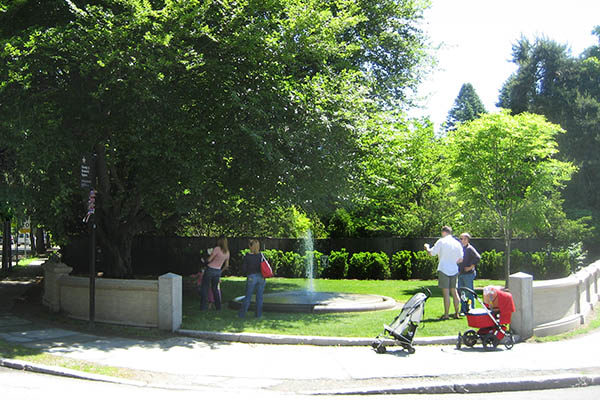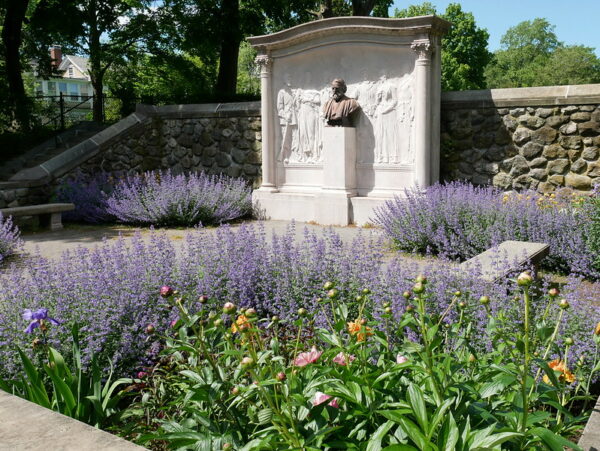When the Plant Club made the first of many contributions for children’s gardens at the Margaret Fuller House, it was 1910. CP&GC remains vibrant and continues City work, retaining its founders’ energy and commitment to outreach.
Fresh Pond Reservation
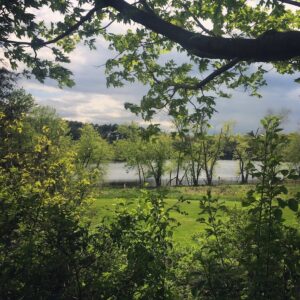 The Fresh Pond Reservation – 162 acres surrounding and protecting the 155-acre Fresh Pond Reservoir – is the largest open space in densely populated Cambridge. Assembled by the city’s water department in the late 1800s, the Reservation’s landscape was shaped by an 1897 Olmsted Brothers plan that featured carriage roads and varied views. Over the years, the department was hard pressed to match maintenance to use, and by the 1950s, the Reservation had fallen into deteriorated condition. In 1962, members of the Plant Club and Garden Club (then separate clubs) joined forces to advocate for the restoration of the Reservation.
The Fresh Pond Reservation – 162 acres surrounding and protecting the 155-acre Fresh Pond Reservoir – is the largest open space in densely populated Cambridge. Assembled by the city’s water department in the late 1800s, the Reservation’s landscape was shaped by an 1897 Olmsted Brothers plan that featured carriage roads and varied views. Over the years, the department was hard pressed to match maintenance to use, and by the 1950s, the Reservation had fallen into deteriorated condition. In 1962, members of the Plant Club and Garden Club (then separate clubs) joined forces to advocate for the restoration of the Reservation.
The clubs began by focusing on Black’s Nook – the most degraded area of the Reservation. A small pond that was once connected to Fresh Pond, Black’s Nook had – given its accessibility from Concord Avenue – become an unsanctioned dumping site. In 1962, the clubs reached out to city officials with a plan for dredging the pond and then replanting the banks with native trees and shrubs.
In the spring of 1963, the Cambridge DPW kicked off the project, hauling away 93 truckloads of debris (appliances, car parts, tires, bedsprings, and more). A city crew then prepared the surrounding area for planting. The clubs contributed 40 trees (white pines, red maples, and a specimen red oak), siting the trees, supervising planting, and then watering over a hot summer. Plantings in the following years included nut tree and beech groves.
The Cambridge Committee on Public Planting
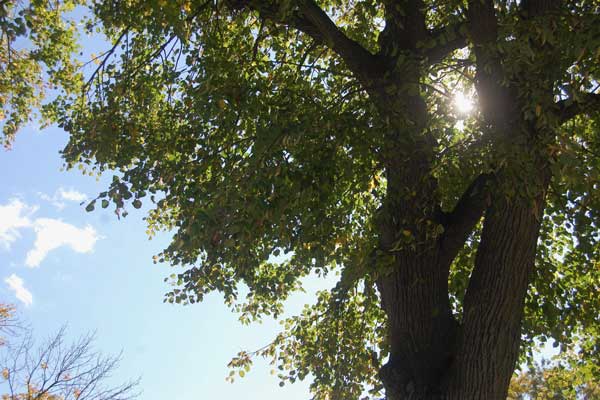
Early work at Fresh Pond Reservation led CP&GC members to think citywide. In the ’70s, two activist members proposed and established the Cambridge Committee on Public Planting to advise and support the city in improving public planting. Serving as the Committee’s first chairs, they advocated for a city arborist and a street-tree planting program. When the city’s first arborist was hired, the club was supportive by funding the DPW’s first water tank, providing contributions for street trees, and supplying hand-held computer (novel then) for a street-tree census. Since the creation of the Committee in 1979, a succession of club members have given their time serving members and as chairs. Today, the Committee has a diverse membership open to all interested Cambridge residents. The expertise of club members is a significant resource as the City maintains existing public plantings and considers new ones.
Cambridge Common
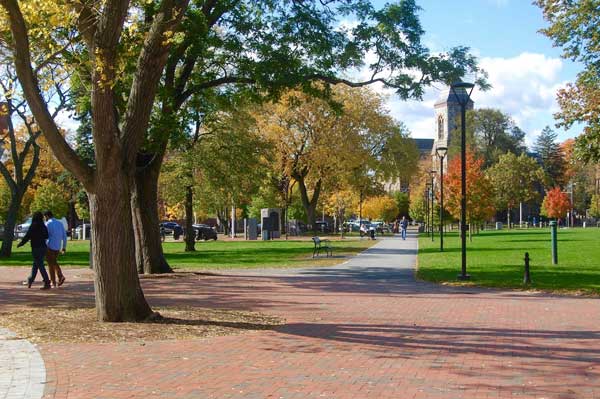
The Cambridge Common is a central part of busy Harvard Square, and its 16 acres are traversed by an estimated 10,000 pedestrians and cyclists daily. This urban green space is a National Historic Landmark where George Washington took command of the Continental Army, and home to the famous “Washington Elm.” During World War I, the Common’s trees were removed to make way for army barracks. The post-war Common was left in shabby condition, and late in the 1920s, the Plant Club began a replanting project that continued for over twenty years. Work began in 1930, with the planting of three elm trees in honor of the Tercentenary of the Commonwealth of Massachusetts. By the end of the project, the club had planted a total of 3,500 border shrubs around the Common.
Craigie Street Park
On May 14, 2009, city officials join with West Cambridge neighbors and CP&GC to dedicate and reopen Craigie Street Park. A triangle pocket of land given in 1971 by a CP&GC member and her brother as a gift to the Cit, the park was refurbished in 2009 with Community Preservation Act funds and substantial assistance from CP&CC. The club continues to keep an eye on the park and funds professional pruning of the park’s yew hedge.
Lower Longfellow Park
CP&GC began advocating for Longfellow Park in 2015 as we had concern about existing trees, planting around the poet’s monument, crumbling stone steps, non-working light posts, and lack of benches. Despite the tall order, the City responded quickly by replanting the area around the monument to Longfellow. The club funded the pruning of the park’s crabapples, planted two crabapples and added new lilacs to an existing grouping. New benches, new lights, new drought-tolerant perennials, and new trees near Mount Auburn Street have all been well used by visitors and residents alike. Photo: Leslee_atFlickr

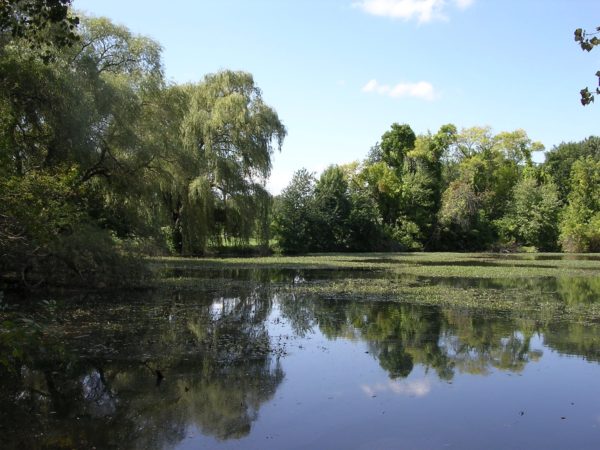 Since the adoption of the master plan, the CP&GC has continued its involvement – advocacy and funding for planting – at the Reservation. In 2002, a club gift of $9,000 allowed completion of a sugar maple allée at Kingsley Park. Then came a return to the site of the club’s first project – Black’s Nook. Forty years on, the meadow had become overgrown with invasive plants, and some trees had died. Again, the club engaged with the Water Department, but this time the planning process was extended over seven years and involved a number of consultants. Advice from club members (and the donation of some club funds) helped shape the design, from placement of the Concord Avenue entrance to details concerning “hopping” stones (a feature of the original 1963 project). In 2012, the club presented the Water Department with a check for $25,000, earmarked for larger caliper trees. Most recently (in 2021), the club planted three white oaks at Kingsley Park in memory of a member of the original Black Nook’s team.
Since the adoption of the master plan, the CP&GC has continued its involvement – advocacy and funding for planting – at the Reservation. In 2002, a club gift of $9,000 allowed completion of a sugar maple allée at Kingsley Park. Then came a return to the site of the club’s first project – Black’s Nook. Forty years on, the meadow had become overgrown with invasive plants, and some trees had died. Again, the club engaged with the Water Department, but this time the planning process was extended over seven years and involved a number of consultants. Advice from club members (and the donation of some club funds) helped shape the design, from placement of the Concord Avenue entrance to details concerning “hopping” stones (a feature of the original 1963 project). In 2012, the club presented the Water Department with a check for $25,000, earmarked for larger caliper trees. Most recently (in 2021), the club planted three white oaks at Kingsley Park in memory of a member of the original Black Nook’s team.